Care Coordination and Nursing Homes: The Nature of the Issue
Care coordination is a considerable problem for long-term facilities, including nursing homes, due to the amount of interactions between specialists (Primaris, 2015).
Examples of specialists that collaborate with nursing home residents: physicians, nurses, residential staff, certified healthcare assistants, internists (Primaris, 2015).
In the context of nursing homes, care coordination can take diverse forms:
- Close collaboration with hospitals to get detailed health information pertaining to new nursing home residents.
- Timely exchange of information with hospitals to manage and address residents’ need for acute care services.
- Focused communication with residents and families in order to develop and improve care plans or keep families updated on their relatives’ health status in case of acute issues (Primaris, 2015).
Dear audience, as those working in long-term care, you definitely know how important it is to practice a patient-oriented approach to care provision. In nursing, the coordination of care is aimed at improving the organization of patient care activities involving different participants in order to facilitate service delivery and maximize positive outcomes for the patient. Without exaggeration, care coordination is the issue of utmost significance for nursing homes since these receiving facilities are to organize effective interactions between residents/families and medical and care staff. In its guide for nursing homes, Primaris (2015) highlights that care coordination is a very broad topic for such facilities since it involves purposeful communication with both hospital service providers and residents and their families. In this presentation, we will delve into the ethical and policy factors affecting the organization of such communication and discuss issues surrounding care coordination in nursing homes.
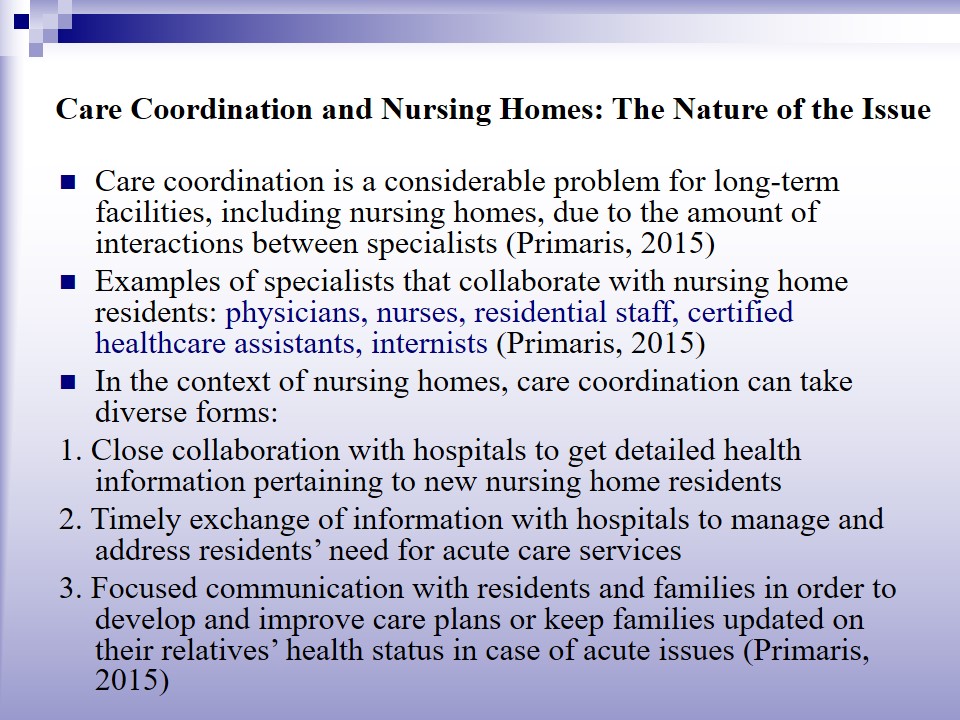
Care Coordination/Continuum of Care in Nursing Homes and Ethical Standards
- The Code of Ethics for Nurses establishes non-negotiable ethical standards that any healthcare institution is supposed to support and implement.
- Provision 7.1: nurses should maintain their commitment to patients “throughout the continuum of care” (American Nurses Association, 2015, p. 42).
- Provision 3.1 discusses issues at the confluence of patient privacy and teamwork.
- Provision 3.1: nursing professionals are responsible for providing necessary and accurate information to those “who have a need to know” (ANA, 2015, p. 21).
- Provision 3.1: the principle of patient confidentiality is not absolute and can be modified to promote safety or comply with mandatory reporting requirements (ANA, 2015).
- Provision 3.1: data security must be emphasized when sharing data using electronic health records (ANA, 2015).
- Provision 3.1: to be disclosed to other parties, patient information should be relevant to the planned task (ANA, 2015).
- Provision 1.3: nurse leadership involves planning care in a way that reduces the threat of patient suffering and using unwanted treatments (ANA, 2015).
- Provision 1.5: nurses can take on the role of care coordinators and are expected to create “the culture of civility and kindness” regardless of the role that they fulfill (ANA, 2015, p. 15).
- Provision 8.3: nursing professionals have to understand specific issues associated with cultural/ethnic diversity and create conditions to facilitate care provision to dissimilar populations (ANA, 2015).
- Provision 2.3: nurses are expected to foster collaborative planning (ANA, 2015).
- Provision 2.3: collaboration should involve mutual respect/trust and shared decision-making and responsibility; collaborating professionals should provide patients with assistance in sorting out priorities and deciding between alternatives (ANA, 2015).
- Provision 2.3: nurses that fulfill different roles are interdependent and are supposed to share responsibility for care outcomes (ANA, 2015).
- The ethical value of patient-centeredness finds reflection in the expectation to organize interdisciplinary collaboration in a manner that allows developing care plans within two calendar days of admission (Unroe, Ouslander, & Saliba, 2018).
As you know from everyday practice, care coordination in long-term facilities involves a substantial amount of collaboration. To analyze care coordination from the viewpoint of ethical issues, it is helpful to consult with the foundational document by the American Nurses Association. First of all, the code includes Provision 7.1 which establishes nurses’ commitment to patients as the chief principle related to care continuum (ANA, 2015). Next, Provision 3.1 provides a detailed discussion of nurses’ ethically appropriate approach to sharing confidential and sensitive information (ANA, 2015). From this provision, it is clear that for care coordination efforts to be ethical, data sharing in such activities should be purposeful, compliant with the need-to-know restrictions, and aimed at maximizing patient safety without compromising data security. As professionals caring for specifically vulnerable populations, you are expected to put these national ethical standards into practice on a daily basis.
To continue, from Provisions 1.3 and 1.5, it is clear that non-maleficence and the promotion of kindness are among the basic values pertaining to different roles, including care planning (ANA, 2015). Interestingly, the guide for nursing homes by Primaris (2015) also states that care coordination activities should emphasize the patient and his or her preferences and unique health risks (ANA, 2015). Finally, Provision 8.3 puts a premium on nurses’ ability to recognize the needs of different populations. To some degree, it implies that there should be no ethnicity and race-related differences in satisfaction with care coordination activities among nursing home residents.
Apart from what has been mentioned before, there are other provisions in the Code of Ethics that might have relevance to the organization of care coordination activities. Thus, Provision 2.3 sheds light on specific expectations of nursing specialists, including enabling different parties to participate in collaborative care planning and explaining to patients everything that they need to know about available care options. Moreover, this part of the Code of Ethics highlights the importance of sharing responsibilities and getting involved in intraprofessional collaboration with other nurses, which also has to deal with coordination. Next, patient-centeredness is a common priority that is emphasized in current performance expectations associated with nursing homes’ role.
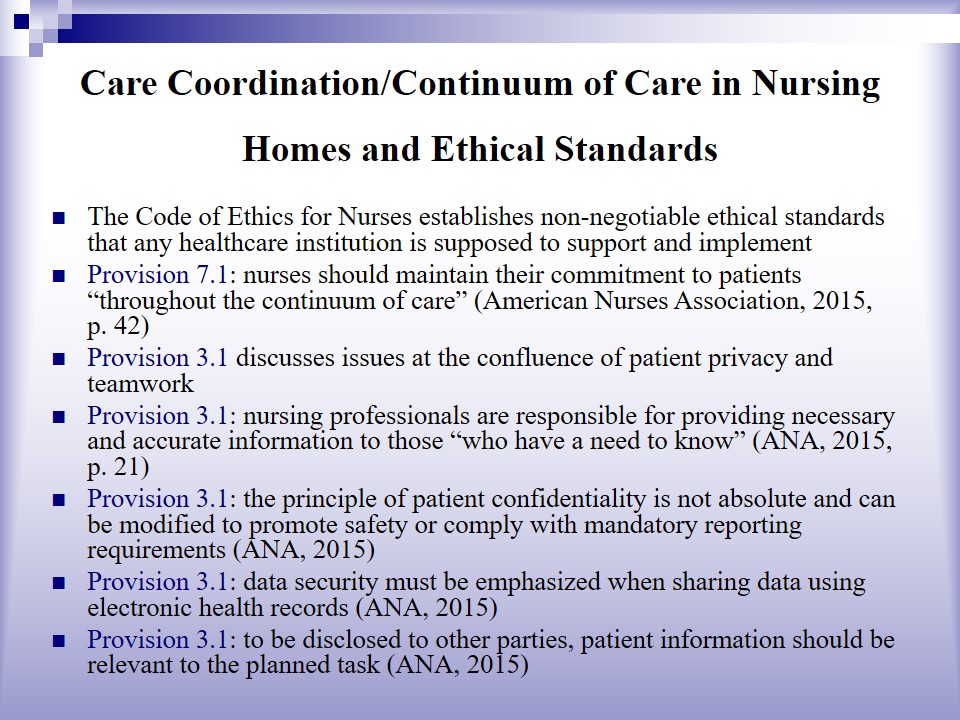
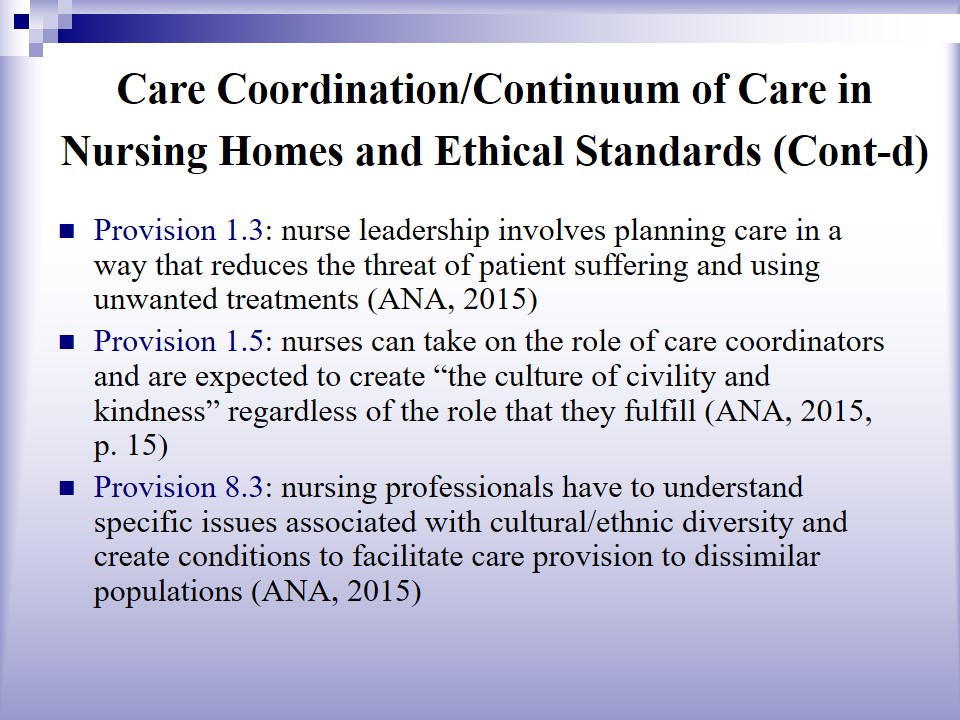
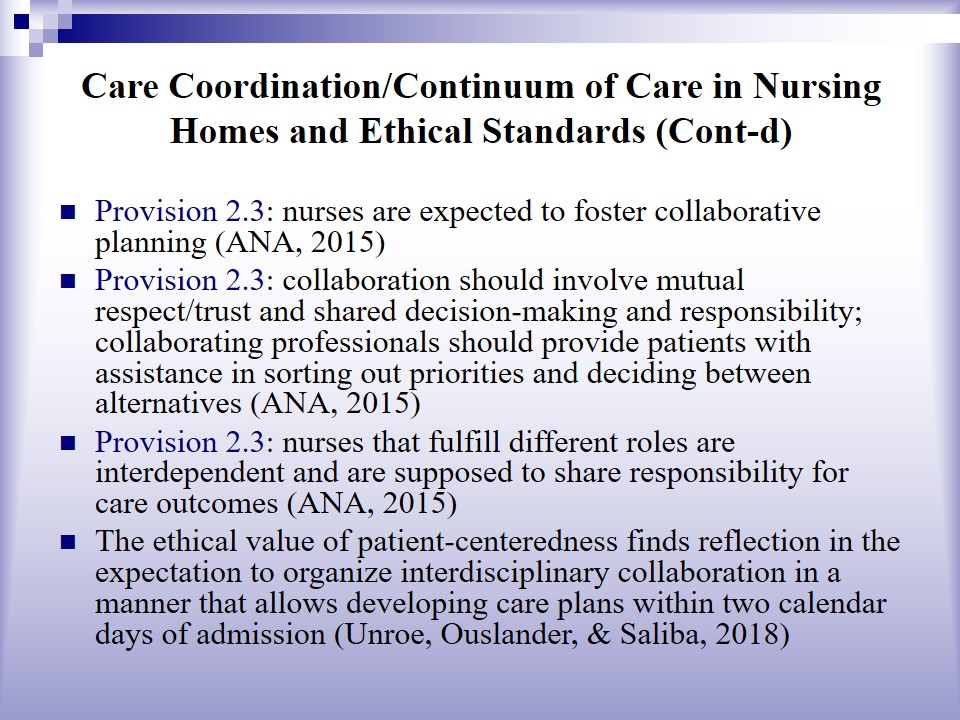
Social Determinants of Health and Similar Factors
To facilitate care coordination, policies targeted at nursing homes should emphasize practices that reduce health disparities.
Disparities can be related to cultural and linguistic differences, such as lack of interpreters or failure to give due consideration to residents’ culture-specific care needs; also, they stem from prejudice and human rights violations (ANA, 2015).
Social determinants of health (SDOH) refer to the various factors that contribute to better or poorer health outcomes and largely determine people’s satisfaction with life.
Policy/ethical factors related to SDOHs and factors contributing to health (HealthyPeople.gov, n.d.):
- Access to healthcare – rules regarding the provision of alternative care options in case of nursing homes’ planned closure (Patient Protection and Affordable Care Act, 2010).
- Care quality – data transparency rules for nursing homes to facilitate clients’ informed decision-making (PPACA, 2010); HIPAA privacy requirements related to health information technology.
- Discrimination – non-prejudiced attitudes to patients (ANA, 2015); respect for residents’ and employees’ linguistic identity (Tex. Health and Safety Code, 2017).
- Exposure to crime – mandatory employee background checks; the presence of policies to prevent felons and drug addicts from caring for residents; video surveillance rules to minimize the risks of abuse in nursing homes (THSC, 2017).
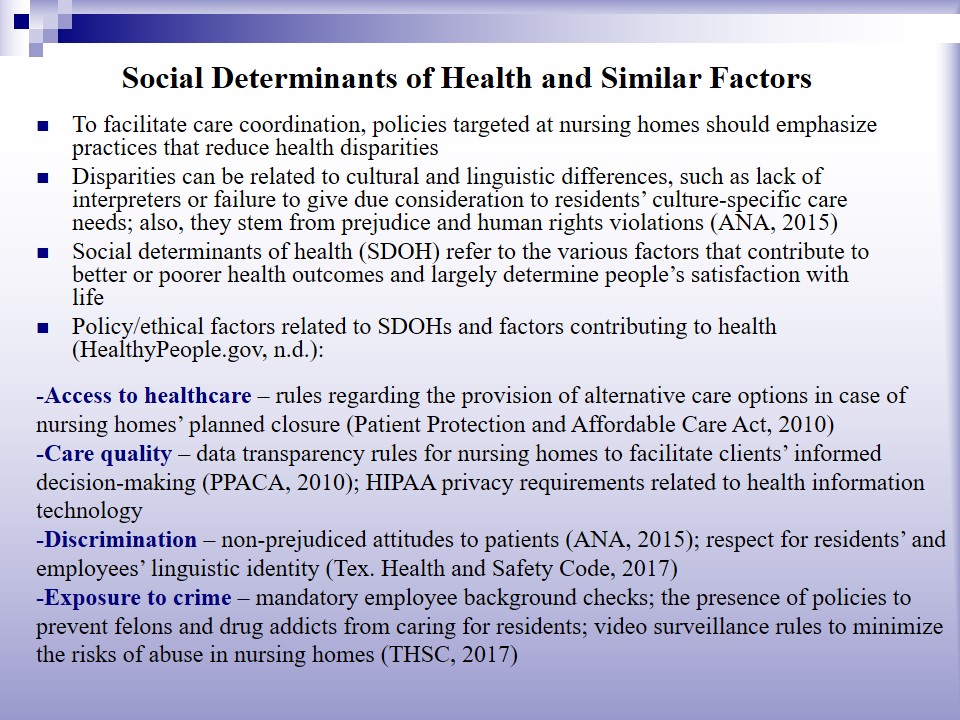
National Policies and Care Coordination in Nursing Homes: Impact and Implications
- PPACA (2010) contains specific data transparency provisions to be implemented by nursing homes; such provisions are to continue nursing home quality improvement efforts initiated due to the Federal Nursing Home Reform Act of 1987.
- Section 6101: nursing homes should publicly disclose personal and job-related information (first/last name, job title, duration of employment, etc.) of anyone in their governing bodies (PPACA, 2010).
- Section 6101: nursing homes are expected to publicly disclose information about their directors, partners, and employees that are responsible for managerial tasks (PPACA, 2010).
- Section 6101: information on relationships with other disclosable parties (any service providers), as well as such parties’ organizational structures, should also be reported (PPACA, 2010).
- Section 6101: nursing home organizations with at least five facilities should implement the proposed ethics programs to reduce both civil and administrative violations and improve ethics education (PPACA, 2010).
- Section 6103: nursing homes should provide accurate and regularly updated information on their performance (service quality, staffing levels, turnover rates, staff training, etc.) for the Nursing Home Compare website (PPACA, 2010).
- Section 6103: such information should be in a clear format and include official complaint forms (PPACA, 2010).
- Section 2717: better quality of care should be ensured through measures and programs to reduce hospital readmission rates (PPACA, 2010).
- Section 6113: if a facility has to be closed, the administrative staff should develop and submit a detailed resident relocation plan beforehand (PPACA, 2010).
- Health Insurance Portability and Accountability Act enacted in 1996 establishes strict privacy and data security requirements for EHRs and EMRs.
- As of 2018, more than 80% of U.S. nursing homes had EMR systems (Powell et al., 2020).
- In 2016, around 30% of nursing homes used EHRs to exchange patients’ health information with other providers (Alvarado, Zook, & Henry, 2017, p. 8).
- Nursing home administrators recognize security concerns and fears of lawsuits as significant barriers to the implementation of health information technology (Powell et al., 2020).
- The use of health IT for data sharing is among the most promising approaches to better care coordination in nursing homes (Primaris, 2015).
Apart from officially expressed expectations peculiar to nursing ethics, it is critical to stay informed of national policies that outline the key rules and priorities that nursing homes are supposed to consider in care coordination. Particularly, PPACA (2010), the law that is more commonly known as Obamacare, contains provisions that impact nursing homes’ activities in the United States with special attention to the transparency of information. Section 6101 is entirely devoted to data reporting requirements aimed at facilitating the control of nursing homes’ patient care activities and establishing the need for ethics programs. Basically, these requirements can contribute to residents’ satisfaction with care coordination activities by increasing nursing homes’ accountability.
To continue on healthcare policies that affect all nursing homes in the United States, it is essential to look at Section 2717 that refers to the ultimate need for better care coordination activities to reduce hospital readmissions (PPACA, 2010). Unnecessary readmissions are an essential care coordination issue for nursing homes, and the latter may sometimes be required to start offering new post-acute care services to minimize avoidable readmissions (Primaris, 2015). Next, Section 6103 of PPACA (2010) might contribute to patient safety in care coordination activities by enhancing residents’ and families’ access to credible information about nursing homes’ actual human resources and performance. Finally, Section 6113 refers to coordination activities peculiar to relocation (PPACA, 2010). Thus, nursing homes that are about to close are supposed to coordinate efforts with other providers to make sure that all residents will be accepted by appropriate facilities. This may increase the complexity of coordination activities undertaken by nursing homes since the relocation options need to be selected with special attention to individual residents’ care needs.
Similarly to other types of facilities, nursing homes are affected by HIPAA provisions regarding the security of patients’ health information. As the recent study by Powell et al. (2020) indicates, the majority of U.S. nursing homes make use of at least basic EMRs in order to improve the coordination of activities. Due to their technical characteristics and opportunities for data integration, EHRs are much better for care coordination, but only 30% of nursing homes use them to improve interprofessional collaboration (Alvarado et al., 2017). Despite the promise of health IT for care coordination, nursing homes are not entirely confident in their ability to use technology without facing risks to the safety of patient data, which is an important ethical concern.
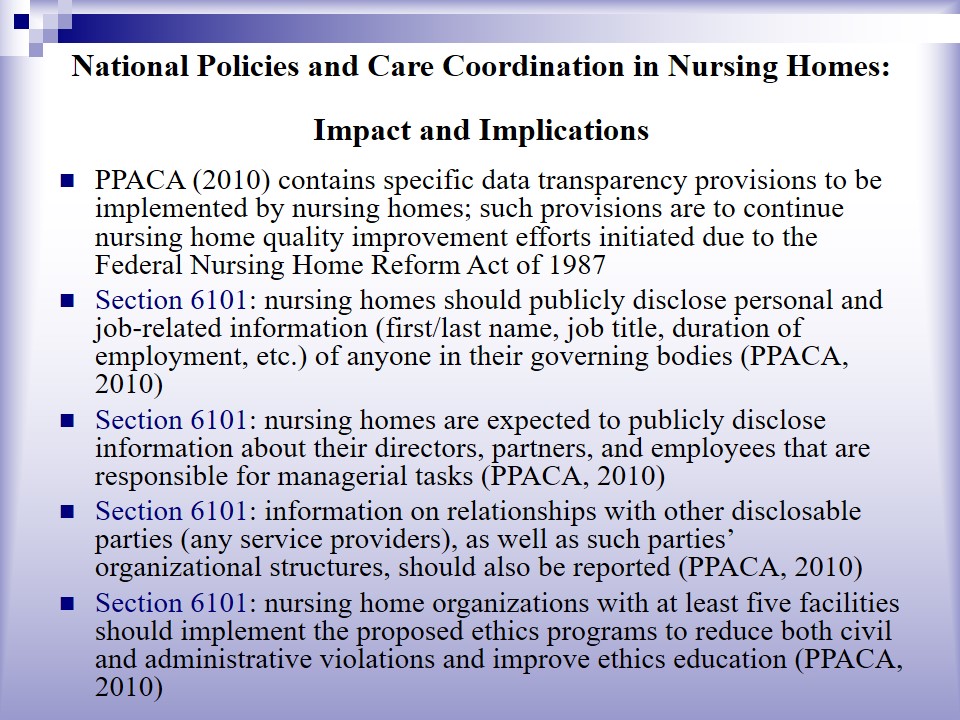
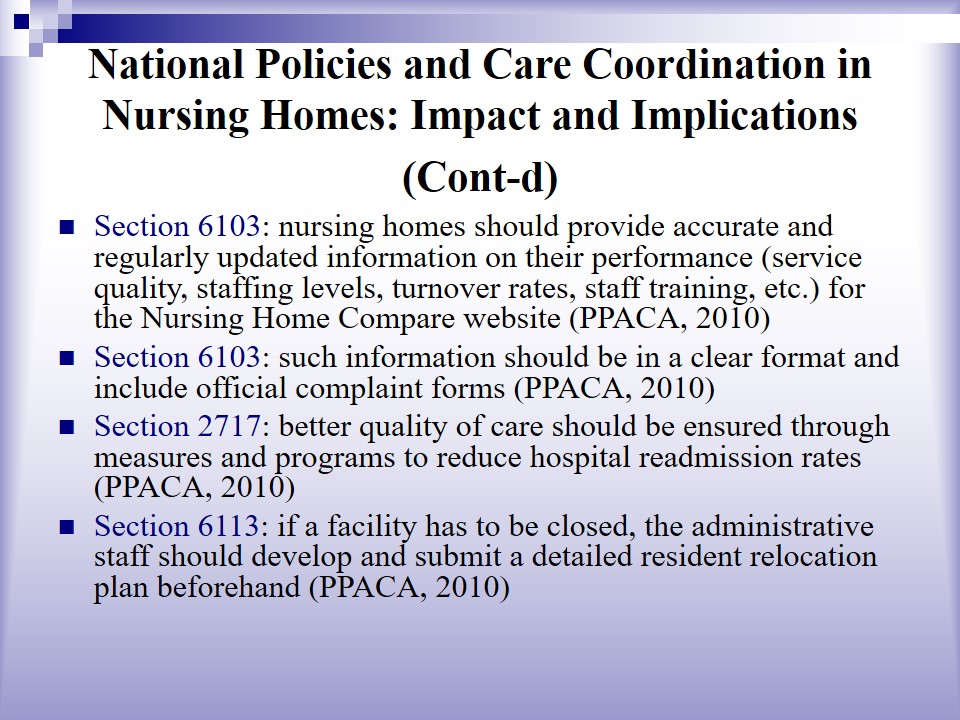
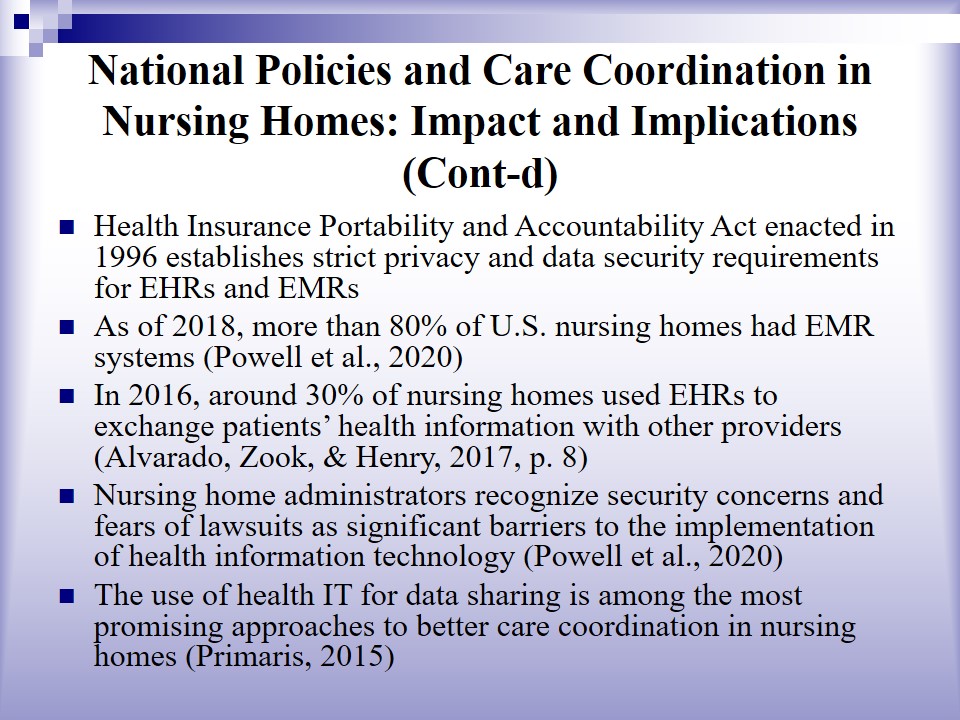
State/Local Policies and Care Coordination in Nursing Homes: Impact and Implications
- The City of Houston does not have very specific local policies for nursing homes – such facilities are supposed to comply with THSC (2017).
- Chapter 242 of THSC (2017) states that:
- To provide high-quality care, licensed nursing homes must meet a range of requirements related to services (coordination, accessibility, care continuity, professionalism, etc.);
- Regardless of the purpose of such actions, it is not appropriate to impose language requirements on residents and employees with native languages other than English and prevent them from communicating in these languages;
- The freedom of language use has to deal with the requirement to respect patient dignity and individuality (ACA, 2015).
- To promote safety and patients’ active participation in care decision-making, it is essential to provide residents and their families with the opportunity to control the quality of services.
- In nursing homes, video camera surveillance is a popular measure used to respond to the threats of elder abuse.
- In Chapter 242 of THSC (2017), the following provisions regarding electronic surveillance are presented:
- The guardians and other representatives of residents have the right to request electronic monitoring;
- Such representatives can file complaints to the Texas Department of Human Services in case of nursing homes’ failure to comply with their requests;
- Nursing homes in Texas cannot deny services to new clients or try to remove any residents because of the requests to conduct electronic monitoring;
- All residents living in the room to be monitored should be informed about the planned activities and give their consent in a written form.
- Potential ethical issues: patients’ right to privacy.
- Chapter 250 of THSC (2017) states the following:
- Nursing homes should have effective employee testing policies in place;
- Such facilities cannot allow new employees to work with residents without implementing policies to check their criminal background and test for drug use;
- Upon request from any parties, nursing homes should provide them with access to full statements that describe policies used to select employees that will care for residents.
- Provision 2.2 of the Code of Ethics – nurses’ actions and decisions should help to promote patient safety (ANA, 2015).
- The inability to comply with other healthcare organizations’ and team members’ requests would be a violation of ethical standards and state policies affecting nursing homes in Houston, Texas.
- Nursing homes’ efforts to check employees’ background are important to make sure that all parties involved in care planning and coordination are professional and employable.
- Chapter 250 of THSC (2017) contains the following provisions regarding criminal background checks in nursing homes:
- Facilities and employers can request information pertaining to employees’ criminal history;
- Such checks can be conducted when an individual applies to a job or in other instances specified by employers and facilities;
- If the employee turns out to have criminal convictions, the facility should review the case to make an informed decision concerning this person’s ability to work with residents.
- Provision 2.2 of the Code of Ethics: healthcare professionals are to recognize situations involving the risks of conflicts between personal and professional values and avoid such situations (ANA, 2015).
- Some facilities give preference to inexpensive employee background checks, which can affect patient safety (Harney & Kennon, 2018).
State policies, such as THSC (2017), can also have implications on local nursing homes’ care coordination efforts. For these institutions, coordination is about effective communication between multiple parties (Primaris, 2015). Potentially, the provisions of the code regarding residents’ and employees’ freedom of language can give rise to conflicts and misunderstanding between providers and linguistic minority patients. This can create barriers to effective exchange of information regarding preferred treatment options and key health issues, which is crucial for effective care coordination efforts. Basically, the question of whether or not restrict one’s language freedom may introduce the dilemma of respecting patients’ identity and individual decisions versus facilitating easy and timely collaboration between those to participate in care coordination.
Effective collaboration between residents’ representatives and nursing homes is a prerequisite to proper care coordination, but conflicts related to monitoring can serve as barriers to it. As you can see from the bullet points, the law of Texas protects the right of residents’ representatives to monitor the process of care provision to prevent abuse. Despite helping to promote safety, such provisions also involve the risks of ethical issues and dilemmas, such as the need to provide necessary surveillance assistance to specific patients without infringing upon their roommates’ privacy rights.
To continue, Chapter 250 of THSC (2017) impacts nursing homes by implementing rules to control their collaboration with other parties involved in the care process, including patients. To make sure that patients will be safe, different parties may wish to check nursing homes’ internal policies prior to engaging in professional partnerships. Nursing homes are obliged to offer this opportunity to external organizations and individuals to prove their ability to carefully select employees, thus promoting resident safety. In the context of coordination efforts involving nursing homes, it means that such facilities are required to grant access to information on their internal rules to potential care coordination partners if such need arises. As for the ethical issues and concerns, this requirement is aligned with the expectation to prioritize patient safety and put it first in any conflicting situation (ANA, 2015).
Finally, it is important for nursing homes to bring together qualified professionals with a good reputation to organize successful care coordination and provision activities (Primaris, 2015). Employee selection policies play a huge role in achieving this goal. This slide summarizes state-level requirements that all nursing homes are expected to meet. The potential problem is that facilities are granted some power in evaluating the cases of employees with the criminal past. Of course, Chapter 250 of the discussed code provides a large list of offenses related to violent behaviors that completely bar anyone from working in nursing home settings (THSC, 2017). At the same time, personal relationships with employees/job applicants or severe personnel gaps may sometimes affect facility managers’ decision-making. Poor employee choices can also stem from conflicts between facilities’ financial interests and ethical obligations (Harney & Kennon, 2018). Thank you very much for attending the presentation, this is it for the main policy and ethical issues affecting nursing homes.
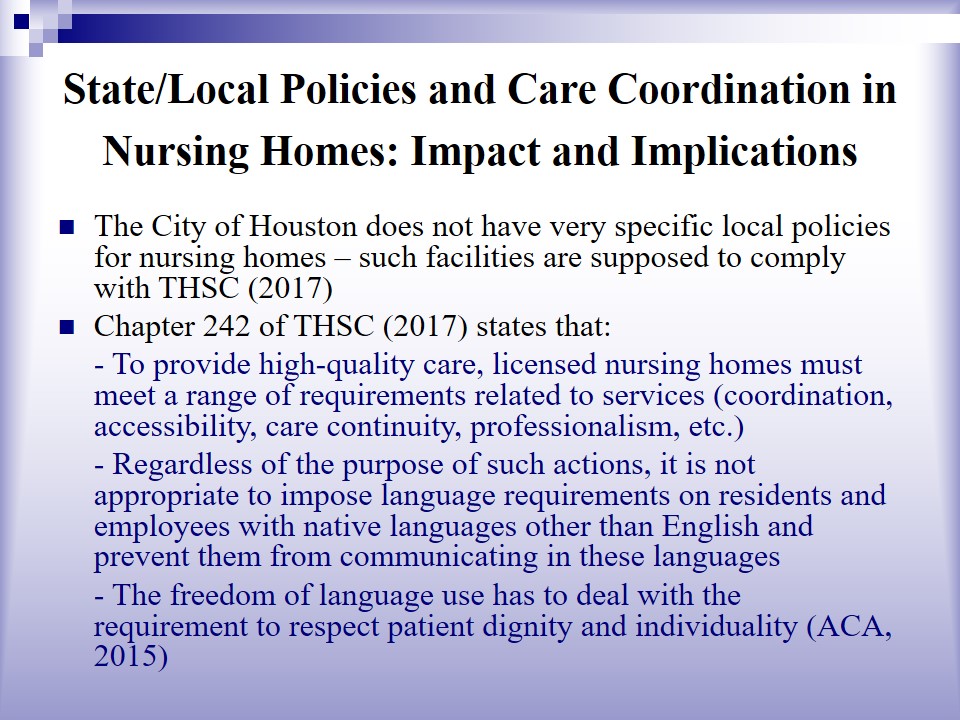

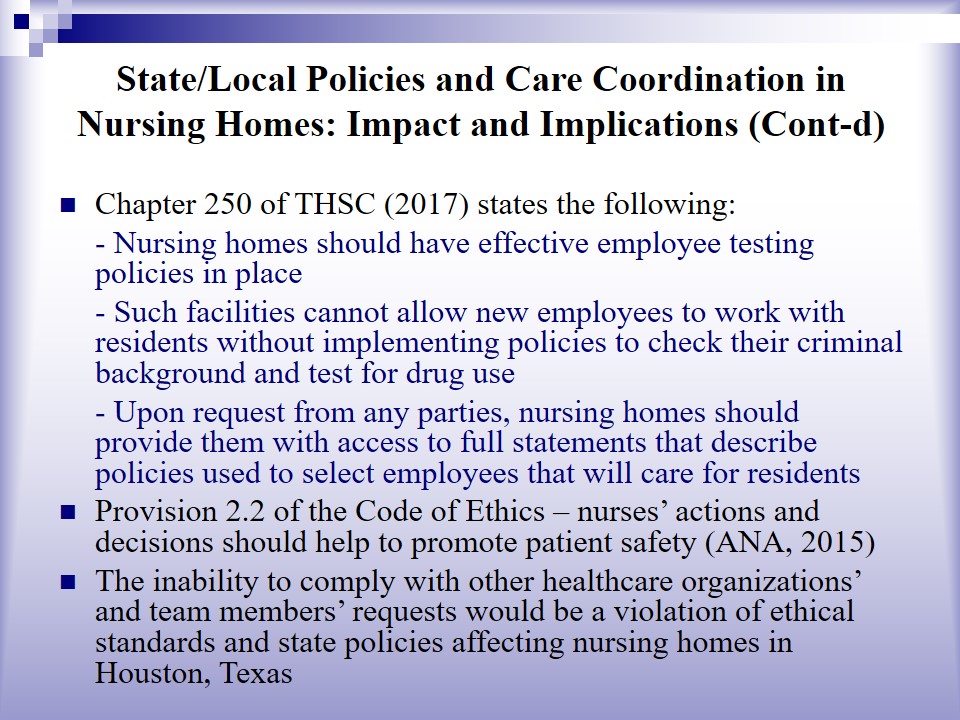
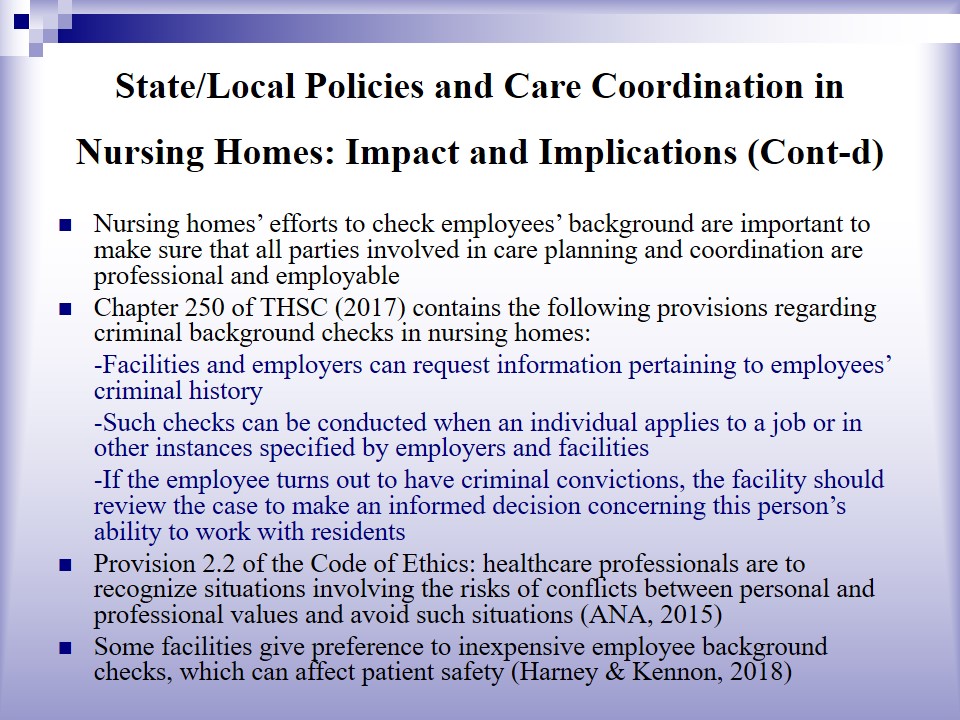
References
Alvarado, C. S., Zook, K., & Henry, J. (2017). Electronic health record adoption and interoperability among US skilled nursing facilities in 2016. ONC Data Brief, (39), 1-14.
American Nurses Association. (2015). Code of ethics for nurses with interpretive statements. American Nurses Association.
Harney, A., & Kennon, K. (2018). Need for stricter screenings of nursing home workers. Sociology International Journal, 2(6), 833-837.
HealthyPeople.gov. (n.d.). Social determinants of health. Web.
Patient Protection and Affordable Care Act, 42 U.S.C. § 18001 et seq. (2010).
Powell, K. R., Deroche, C. B., & Alexander, G. L. (2020). Health data sharing in US nursing homes: A mixed methods study. Journal of the American Medical Directors Association. Web.
Primaris. (2015). Coordinating care: A guide for nursing homes. Primaris: Healthcare & Business Solutions.
Tex. Health and Safety Code § 242 (2017).
Tex. Health and Safety Code § 250 (2017).
Unroe, K. T., Ouslander, J. G., & Saliba, D. (2018). Nursing home regulations redefined: Implications for providers. Journal of the American Geriatrics Society, 66(1), 191-194.